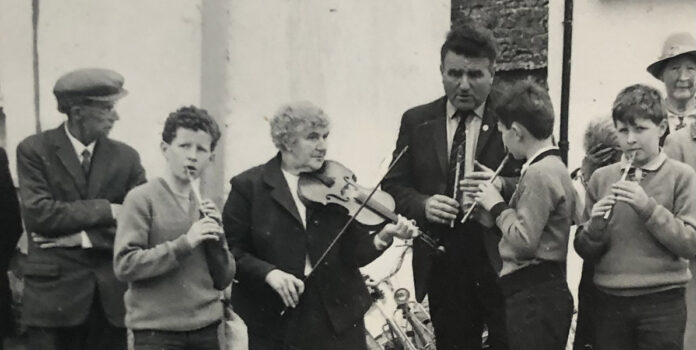A fighter, a musician, a businesswoman, a lovable rogue, a leader of the late-night sessions, Lahinch woman Susan O’Sullivan was a one of a kind.
Born in Bartrá, just outside Lahinch, in 1892, Susan took up the fiddle when she was eight years old.
As well as being a talented player in her own right, her house became the main Sunday evening venue for some of the greats of the Clare trad scene, including Willie Clancy, Seamus Ennis and Junior Crehan.
Later in life, she was also a great advocate of passing on the tradition to the young, and served as president of Clare Comhaltas in the 1960s.
But in her younger days, in the heat of the War of Independence, Susan lent her considerable intelligence and skill to the Republican cause, and it was this involvement that led to her family home in Lahinch being burned by the Black and Tans in the wake of the Rineen Ambush in 1920.
“She used to pass on intelligence to the volunteers and she procured guns for them,” said Susan’s granddaughter, Siobhan O’Sullivan, one of the organisers of the Lahinch Traditional Irish Music Festival.
“She worked in Flanagan’s Bar, her brother Tommy was running it at the time. She was clever, she realised who the weak links were [in the British Army], she knew the ones who had the drinking problems.
“She would ply them with alcohol in return for pistols and guns. She actually had a long trench coat that she stitched pockets into, and she would hide the guns there.
“She would leave the pub and she might have two pistols on her and nobody would know. Even though the military were on the street, they were none the wiser.
“Prior to leaving Ireland in February of 2021, she got intelligence that there was going to be a raid and they were going to target Ignatius O Neill [who led the Rineen Ambush]. She actually saved his life through the information that she heard and passed on.”
Tragically, Susan’s boyfriend, Packie Lehane, was asleep in the attic of her house when it was set alight during the reprisals for the Rineen Ambush in September of 1920, and he was burned to death. This incident shaped Susan’s life, and led to her fleeing to America.
“The burning of her house was the lowest point of her life, as it was for so many of the people who were affected in Lahinch,” said Siobhan.
“The soldiers kicked in the door, broke the windows, stole what they could, they were drinking pints of whiskey. They told her that she had a minute to get out.
“She said to them that she had an invalid sister upstairs, and the soldiers said that they didn’t care if she had five invalid sisters upstairs.
“So she had to go up that narrow stairs into the upstairs room and carry her sister down on her back and brought her to safety out the back, but poor Packie Lehane died.
“It was something that haunted her all her life. That was an awful tragedy. It was a big scar for her, a big weight for her to bear.
“She had to leave the country after that, like many of the local volunteers.
“She had to hide in the bushes, up around Doolin. It was a very tough time for her. She was mentally scarred by it.
“The trauma of that. She was 28 years of age at the time, they say in the medical records that she was bodily and mentally fatigued at the time.
“She made her way from Lahinch down to Cobh to get a boat across to America. She had to get away.”
While in America, she did what she could to support the cause at home by raising money and sending it back to Ireland. She also fell in love with an Italian man, a relationship that would never fully leave her.
“She went to America and only stayed over there for two years. But while she was out there, she became involved in a Cumann na mBan group who called themselves the Biddy Early’s. They were all musicians,” said Siobhan.
“They used to play music in America, play gigs, fundraise and send the money back to Ireland for the cause. I often think, and my siblings have said this as well, that her music at this time must have kept her grounded through the worst of it.
“She came back to Ireland in 1922 as the Civil War was raging. She didn’t want to come back at that point, she was in a relationship over in America with an Italian man who was a musician and bought her a fiddle.
“Her mother sent for her and he [her Italian boyfriend]said that she had to return, so she came home with the fiddle. The mother had her set up, she had made a match for her, so she never got back to America.
“The one tune that she always loved was ‘My Love is in America’. That tune always moved her, it always did.”
She married Ruan man Tommy O’Sullivan when she returned to Clare and soon she was making a great go of her two businesses in Lahinch, a guesthouse and a tea room. Unfortunately Tommy, who was a carpenter, had an accident in the 1930s which left the family under great financial pressure.
“She pleaded with the Government of the day to give her a military pension. It was tragic really, that she had to write these pleading letters. She tried everything and got nothing,” said Siobhan.
“She was no different from the majority of Cumann na mBan members. If you were a man you were looked after well. My grandmother didn’t get her medals until 1945, but no pension out of it.”
All through her amazing life, music was her constant companion. From when she first picked up an instrument as a youngster, to her older days in Lahinch, the tunes, the sessions and the craic were always part of her life.
“She started learning the fiddle from the age of eight or nine, she was taught by a man called John Madigan from Ennistymon who had a céilí band which she eventually joined,” said Siobhan.
“Every Sunday night she had a session in her house, in her family home. And at these sessions you would have had the likes of Willie Clancy, Dr Bill Loughnane, Seamus Ennis, Junior Crehan and people like that who would come and stay with her every Sunday night.
“My father, God rest him, as a child he would sleep in a room overhead where the music was played. He said it would go on to all hours of the morning, Sunday night after night without fail.
“She does fit into that West Clare style of music. She must have had fierce notions about herself as well. When she came back from America, she went up to Dublin with whatever few bob she had and she went up to Waltons, the music place, and she got a vinyl made of her tunes.
“She fiddled her way through life. She was still fiddling up to the age of 89.”
The first ever Lahinch Irish Traditional Music Festival will run from Friday, April 19, to Sunday, April 21, and will feature dozens of Ireland’s best loved musicians in free sessions throughout the village.
The festival will be officially opened in Flanagan’s Pub by Labhrás Ó Murchú, the Director General of Comhaltas Ceoltóirí Éireann.
That night will also feature a special performance of Dermot Petty’s play ‘Two Days in September’ based on the Rineen Ambush as well as a history of the life of Susan O’Sullivan.
“The play, ‘Two Days in September’ is a very important part of the festival. That documents Rineen and the aftermath of the ambush. Anyone who lives locally and hasn’t seen this drama by Dermot Petty, I would strongly suggest that they should see it. Little did we know that when we went to see it in Doolin that our own grandmother’s name was part of it, which was a very sweet moment for us,” said Siobhan.
“We have put together a presentation which documents her life, from her humble origins out in Bartrá where the family were known as ‘the gentry’, they had quite a lot of land out there for whatever reason.
“I went out to Bartrá and photographed the house and the power point looks at what Lahinch was like back in those days, the old Lahinch. It gives you a sense of what life was like when she was growing up. The importance of the West Clare Railway to Lahinch, things like that.
“It also mentions all of her musician friends, people like Chris Droney. I met Chris the year before he died to ask him about his memories of Susan. He told me that, as an 18 year old, he had just bought his first Moris Minor.
“He got together with a few of his friends from Bellharbour, because they had heard that there was a woman in Lahinch making ice-cream. That was my grandmother back from New York after her time on the run. She was the first person in Clare to have an ice-cream maker, which her husband actually designed and built. So young Chris Droney comes into the shop to buy ice-cream. She says, ‘are you young Droney? You’d better have an instrument in the car’. So from the age of 18 he was coming down to the house every Sunday night without fail.
“I spent a lovely afternoon chatting to Sean Conway from Ennistymon recent. He said, ‘when you went to Susie’s, you might go in there at 7pm after the dinner, you were lucky to get home by 4am. Once you get into the tune, the stories and the chat that was it’.”
The festival will feature free performances from some on Clare’s best known musicians including Siobhan Peoples, Blackie O’Connell and Denis Liddy. There will also be a céilí in Moy Hall on Saturday afternoon, April 20, from 3pm to 6pm, featuring the Dal Gcais Céilé Band.
“The festival has expanded a lot from where it once was. It initially started with four pubs taking part but it has expanded now so that practically every pub and hotel in the village is hosting some music. A few venues don’t have any organised gigs in them but they will be very useful as overflow venues for the festival, which we certainly will need,” said Siobhan.
“We are back to back with gigs in the pubs, so we will need places where the musicians can meet up and chat. We have people coming from all over the country, from Donegal, from Cork, from Kilkenny and Tipperary
The first ever Lahinch Irish Traditional Music Festival is being made possible thanks to support from Creative Ireland as well as Lahinch Green Party councillor, Liam Grant.
For more see Lahinch Traditional Music Festival page on Facebook.
Andrew Hamilton is a journalist, investigative reporter and podcaster who has been working in the media in Ireland for the past 20 years. His areas of special interest include the environment, mental health and politics.



